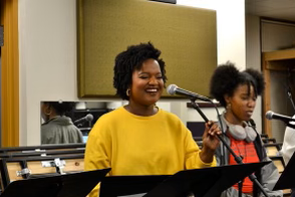
A decade of trailblazing and trauma defined jazz pianist Earl “Bud” Powell’s life prior to recording “Piano Interpretations” in 1955. Born in Harlem during the neighborhood’s cultural renaissance, Powell was in his teens when he and fellow pianist Elmo Hope discovered many of the cornerstones of modern jazz theory. Their ideas brought them into an informal club of modernist musicians, including trumpet player Dizzy Gillespie, saxophonist Charlie Parker, and pianist Thelonious Monk. They developed a fast, complex, chord-based style of improvisation and composition later known by the onomatopoeia “bebop.”
Powell was just 19 years old when, armed with advanced piano technique in both the classical and jazz genres, he joined the band of swing trumpet player Cootie Williams. However, his stint in the band was short. In early 1945, Powell was beaten by a Philadelphia police officer and received severe brain injuries. Shortly after, he was hospitalized at Bellevue. Periods of prolific recording and live performance during the following eight years were punctuated by institutionalizations at various New York hospitals. While institutionalized at Creedmoor Hospital, he underwent electroshock and electroconvulsive therapy, which, far from improving his condition, left him mentally incompetent according to New York state’s legal classification system for mental health patients. At the time, hospitals were perilous places for African Americans such as Powell, as their lack of personal or legal representation led to their frequent targeting for experimental medical procedures.
Although Powell was able to resume his career following his release in early 1953, by the end of that year, he began to suffer from attacks of mental illness and forgetfulness, and he communicated less and less with other musicians with whom he worked. Mandated guardianship due to his alleged incompetence gave him no freedom to conduct his own business affairs or manage his own money. By the time he recorded a three-night recording session for Norman Granz’s label Verve in January 1955, he was disoriented and had forgotten several of the tunes on the session’s setlist despite having been familiar with the same pieces prior to his institutionalization.
Despite the setbacks from January, the recording of a new album, “Piano Interpretations,” was scheduled by Verve for New York City’s Fine Sound Studios on April 25 and 27. His accompanists, bassist George Duvivier and drummer Art Taylor, had worked with Powell two years earlier at the Birdland Jazz Club as a trio and consequently were familiar with Powell’s style and repertoire.
The first tune called at the April 25 studio session was pianist George Shearing’s “Conception,” one of the most complex bebop compositions in the jazz repertoire. The tune’s chords, or underlying harmony, are constructed from eleven of the piano’s twelve notes before resolving to the key of Db major. The tune’s bridge briefly shifts to the key of E major before chromatically descending back to the original key. The rapidly shifting harmonic textures, given the piece’s typical tempo of more than 200 beats per minute, pose challenges for jazz musicians attempting to improvise fluent, connected lines.
Powell interpreted the melody with a series of imposing block chords, but contrary to the chordal style Shearing recorded in 1949, Powell used simultaneously descending low notes in the piano’s lower registers to give his version a sense of urgency. Throughout his opening choruses of improvisation, he placed many of his chords on what musicians call the “offbeat,” creating rhythmic contrast with Taylor’s drum pattern on the sock cymbal. Powell followed his fluent right-hand lines and offbeat chords with half a chorus of block chord improvisation and a return to the melody to direct the tune’s atmosphere to a concept closer to its original, Shearing-esque approach. Returning to the final chord to state the original key, Powell, rather than simply end on the final chord, made a remarkable and possibly spontaneous creative choice: a series of solo, descending triads—E, D, and ultimately Db—to lead the tune back to its key. The tension of the D major chord—the only time any “D” chord is heard throughout the entire piece as it is the only one of the twelve tones not referenced in the chord progression of the melody—and its resolution to Db was completed by a delicate drum flourish by Taylor.
The next recording of the session was Coleman Hawkins’ “Bean and the Boys,” another favorite of Powell’s, which he had recorded live at Birdland two years prior. The tune, a contrafact of the jazz standard “Lover Come Back to Me,” featured a bass solo by Duvivier and delicate but haunting upper-register accompaniment from Powell. Three takes of Hoagy Carmichael’s “Heart and Soul” followed. (Carmichael is also the composer of the jazz standards “Star Dust” and “Georgia on My Mind.”)
Haeyong Moon, a technical expert who has worked on Disney films and produced “Broadway Treasures,” is currently working on “Bud Lives,” a film about Powell. After listening to “Piano Interpretations,” she commented on “Heart and Soul”—her favorite track from the album. “The song has everything I love about Bud,” Moon said. “It starts out joyful and light, but he takes the song to a surprising end, demanding the listener to stop and take note—to hear what he has to say, to keep listening until the end. Here is a musician, who is in full control of his musical ability and is determined to reach the heart and soul of listeners for eternity.”
The second recording session on April 27 started with a second full take of “Bean and the Boys”—the longest of the entire session, at nearly five and a half minutes. It was followed by another tune (besides “Conception”) associated with Shearing’s quintet, the Brooks Bowman composition “East of the Sun (and West of the Moon).” The second take was again kept, but, this time, Powell used bold, haunting, and minimalist chords to make a statement of the melody. Powell, known for his long, sweeping lines of improvisation, chose to maintain his minimalist approach throughout the track. Little high-note flourishes created the sound of accompaniment of his left-hand chords, rather than the other way around, as is typical in jazz improvisation. He used short triplet phrases to outline each of the chords, giving the listener the opportunity to clearly hear the direction of the melody and the harmony rather than overwhelm with showy phrases and technique.
A grand total of nine takes of “Star Eyes” completed the April 27 session. The alternate takes were released in 1994 on the album “The Complete Bud Powell on Verve,” which aimed for a complete documentation of Powell’s recordings for the label. The result was an unusually intimate view of conversations in the studio and the frequently spur-of-the-moment decisions made by small jazz groups as they work out details from take to take.
“Piano Interpretations” received positive reviews, particularly from jazz magazine DownBeat, which hailed it as the “beginning of a second career” in an August 1956 issue. This proved to be something of a prophecy: Powell would continue recording albums for Verve and Blue Note before moving to France in the late 1950s as part of the African American jazz diaspora. His career, after years of mental health setbacks, saw success until complications from tuberculosis and schizophrenia led to his premature death in 1966 at the age of 41.
Despite his early death, Powell has remained influential through his recordings, such as the now 70-year-old album “Piano Interpretations”; he inspired trailblazing pianists such as Bill Evans, McCoy Tyner, and Barry Harris; and he largely set the standard for modern jazz piano.
The opinions on this page do not necessarily reflect those of The Sandspur or Rollins College. Have any additional tips or opinions? Send us your response. We want to hear your voice.














Comments are closed.